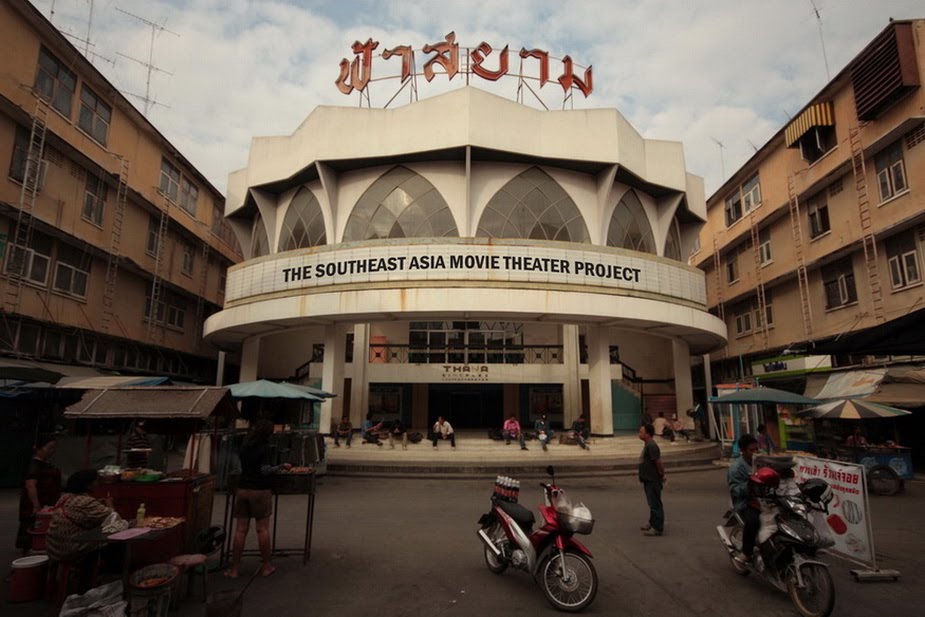Don't let the Chanthaburi Multiplex fool you. The 4 screen cinema hall is only masquerading as a multiplex to avoid an "out of business" notice displayed at the entrance.
Ok, Ok, so it's actually been of business since 2011, but the point is that this chopped up old dame was once a massive single screen stand-alone; the first to be built in the city of Chanthaburi during a theater construction boom that occurred in the early and mid 1980's.
The Chanthaburi Multiplex: Its facade is partially obscured by neighboring shop houses built contemporaneously. As a result, the signage is off-center.
Said theater boom of the early 1980's was not without precedent. At the time, Chanthaburi was in the midst of a thriving economy due to a voluminous gems trade. Ruby mines in Chanthaburi and nearby Trad provinces had high yields in those days. Chanthaburi's well-established gemological industry served as a clearing house for the stones, enriching the town's jewelers and lapidaries in the process.
In fat times, build big, the logic goes. During those fat times, 5 theaters arose across the city.
Lobby of the Chanthaburi Multiplex. Terrazzo floor and solar system ceiling fresco.
The theater opened in 1980 as The Chanthaburi Rama - an 880 seat single screener that replaced a decrepit wooden theater occupying the same plot of land for decades prior. The old wooden theater was called The Sin Tu Nawa.
By the late 80's, four newer theaters had been constructed across Chanthaburi, giving the town one of the densest concentrations of stand-alone movie theaters anywhere in Thailand. While this scenario must have been great for film enthusiasts, it made competition among the various theater owners stiff. As an adaptive measure, in the early 90's the owners of the Chanthaburi Rama divided their grand cinema hall into 4 smaller theaters, making it one of Thailand's first multiplex theaters.
The procedure turned out to be a wise one. With four potential viewing options, the Chanthaburi Multiplex, as it had been renamed, could offer the same viewing fair as all the other movies theaters in town combined.
One by one, Chanthaburi's others theaters began to close their doors, while the Chanthaburi Multiplex hung on until 2011. That year a brand new SF Cinema - Thailand's second largest cinema operator - opened a branch in a new shopping mall just outside of downtown. The Chanthaburi Rama/Multiplex's 31 year run came to a halt.
Theater 4
Remaining details of theater 4
Exit of the stars
Rusting signage
Over the years, Chanthaburi's once hot gem industry has cooled significantly, slowing the overall economy of the city in the process. But the local business community has responded in haste, smartly adapting its historic urban core as an attraction in itself.
Chanthaburi's "Old Town" neighborhood is in the midst of an economic revival, as outside investors and locals alike renovate a 100 year old commercial corridor that winds its way along the edge of the Chanthaburi River. Most of the buildings in Old Town are neo-classical/sino-colonial shop houses, a few of which date back to the mid-19th century.
Across the river, the largest Catholic Church in Thailand anchors Chanthaburi's sizable Vietnamese community. There too, locals have started the process of renovating old houses and store fronts to meet the city's historic rebranding efforts.
All tallied, Chanthaburi's historic preservation initiatives have been successful, but it is still a work in progress. If it continues at this pace, downtown Chanthaburi could be a model for other areas of Thailand looking to capitalize off of their historic architectural and urban assets.
Unfortunately the 5 erstwhile cinema halls in town have not been given the same historic preservation treatment that other buildings have. Three of them, including two of the Chanthaburi Multiplex's four auditoriums, have been turned into nesting houses for swifts, whose salivary nests can bring a tidy sum on the open market.
Chanthaburi's lack of action towards it's collection of old cinema halls, however, is not unique. Thailand in general has yet to develop a workable model for resuscitating old cinema halls for contemporary cultural purposes. But as the phenomenon takes shape in neighboring countries like Singapore, Malaysia and Burma, perhaps Thai preservationists and developers will find inspiration to do the same with some of their own historic theaters.















